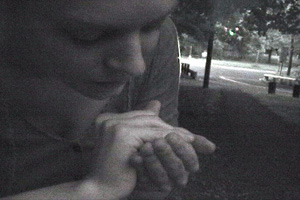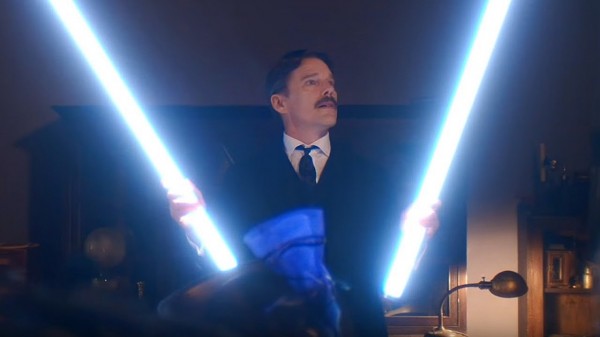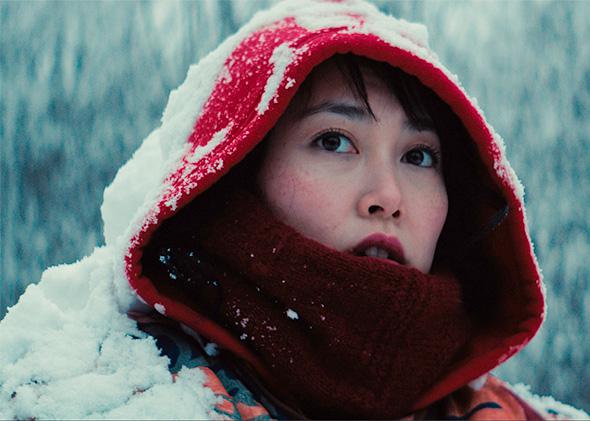(Paradise opens at MoMA on Thursday, September 24th, 2009, and screens through Wednesday the 30th. Go here for details.)
Michael Almereyda’s Paradise begins with a slow tracking shot taken from a moving walkway in an airport. It’s a contradiction of movement and stasis: the camera and its holder are completely still, yet the ground beneath them perpetually propels them forward. Later in the movie, a character will comment that they love natural disasters because they “like that the earth is changing and moving.” Even the modernist architecture of the passageway—cool and steely lines converging in a distant vanishing point and whose hues fluidly shift from blue to green to purple—lends an aura of science-fiction to the shot, as though we are more than moving through a single corridor, but traveling beyond the liminal boundaries of our everyday world.
In a sense, this is exactly what Almereyda accomplishes in Paradise. Courtesy of his intimate camera, we accompany him around the world, but instead of the clichéd, hand-me-down, palm tree-ridden “paradise,” Almereyda reveals glories far more grounded in reality and experience. Privileged moments both private and public make up the film’s narrative, which is less of a progression than a collection, as though each of these vignettes are hanging in that great filmic gallery known as “the screen.”
 I say “privileged” because regardless of whether the scenes take place in a crowd or a small car—or whether the characters seem to be aware of the camera or not—Almereyda’s perceptive eye evokes the sense of a much larger world that (to reuse a character’s words) “is changing and moving,” even if in the smallest of ways. Pigeons gathering on a little girl with a red coat; a little boy playing near a public fountain who falls in; dancing in the street (or on top of a bus!); a young woman staring silently out a bus window at night; kids playing with a charred tree near a campfire; an evening of Miller High Life, poker, darts, and a conversation between twenty-something males (partly in Latin!) about why they still shed a tear every time they hear Napoleon’s name. There’s such relaxed joy in empirical minutiae such as these, and that is what forms the thread that binds these moments together.
I say “privileged” because regardless of whether the scenes take place in a crowd or a small car—or whether the characters seem to be aware of the camera or not—Almereyda’s perceptive eye evokes the sense of a much larger world that (to reuse a character’s words) “is changing and moving,” even if in the smallest of ways. Pigeons gathering on a little girl with a red coat; a little boy playing near a public fountain who falls in; dancing in the street (or on top of a bus!); a young woman staring silently out a bus window at night; kids playing with a charred tree near a campfire; an evening of Miller High Life, poker, darts, and a conversation between twenty-something males (partly in Latin!) about why they still shed a tear every time they hear Napoleon’s name. There’s such relaxed joy in empirical minutiae such as these, and that is what forms the thread that binds these moments together.
While one may see connections between Almereyda and the seemingly quotidian photographs of William Eggleston—particularly in light of Almereyda’s documentary William Eggleston in the Real World (2005)—there also seems to be a strong connection to the “actualities” of early cinema. Those films were but brief instances of daily life, often running less than a minute, and would often focus on public events: workers leaving a factory, passengers getting off a train, carriages passing through a flooded street. There’s an air of opportunity and possibility about them—spontaneous “slices of life” that couldn’t be controlled and couldn’t be replicated. The filmmakers were working with chance: they chose the composition the best they could (perhaps dependent on where they were, and how much time they had to spare), but the events within the frame were out of their hands. Call it serendipity, accidental, or just the art of having one’s camera in the right place at the right time—this beauty of chance and chaos resonates throughout Paradise.
“Paradise” is also the only indication the film gives as to the location of the scenes, and there is no timeline to speak of. MoMA’s description tells us the footage was collected over the course of ten years and nine countries, and I cite this information reluctantly, as Almereyda’s decision not to disclose such details seems significant. As perceived from the film alone, Paradise is a narrative of indeterminate length and breadth: who, what, when, where, why, and how, are never explained. What is the filmmaker’s relationship to the characters—strangers? old pals? fast friends?—or are they just that, “characters” performing for the camera? Perhaps Almereyda himself doesn’t know, and what is important is that he never pretends to know. This ambiguity is precisely the key to the film’s universality: Paradise is anytime, anywhere, anyone. It is all the time, everywhere, everyone.
The whimsy of the road; the sudden bonding that does in seconds what can sometimes take years; a spontaneous gesture or phrase with little significance other than it ties down a moment to a specific time and place. Movies should be filled with more moments like the ones in Paradise. They realize cinema’s capacity for capturing—and reproducing—life experience.
— Cullen Gallagher











